|

“The two Bishops working in tandem can dominate the whole Chessboard”
The Bishop has its origins in the Indian elephant.
Each player starts the game with two Bishops (a dark and light Bishop). Because a Bishop moves diagonally they stay on either the light
or dark cells throughout the game. They are powerful attacking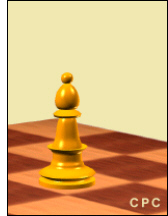 major pieces when they are not blocked in, so you will find it useful to bring them out early. They are sometimes referred to as the Bishop-pair (the others being the Knight-pair and the Rook-pair).
The two Bishops working in tandem can dominate the whole chessboard and to your advantage to keep them on the board until you are well into a game of Chess. Avoid trapping your Bishops behind
Pawns that have become fixed in their positions. A Bishop that works well with the pieces is called a good-Bishop. A Bishop that is trapped by Pawns (lacking mobility) is called a bad-Bishop. Placed at the center of a clear board the Bishop commands 13 cells.
The Bishop is a major piece which moves along the diagonals.
At the start, two of these pieces are used and are placed on
c1 and f1 (white), c8 and f8 (black). The Bishops have their origin in the Persian al-fil (elephant) which was allowed to jump over one cell. This major piece moves on the diagonal cells of the board. Historically, the Bishop was the elephant of Indian Chess, but during the 15th century assumed the present diagonal movement. There is one Bishop for the
light cells and one Bishop for the dark cells. It often happens during a game that one side will have a dark coloured Bishop and the other side a light coloured Bishop. In this case the Bishops of opposite colour are unable to come into contact with each other.
major pieces when they are not blocked in, so you will find it useful to bring them out early. They are sometimes referred to as the Bishop-pair (the others being the Knight-pair and the Rook-pair).
The two Bishops working in tandem can dominate the whole chessboard and to your advantage to keep them on the board until you are well into a game of Chess. Avoid trapping your Bishops behind
Pawns that have become fixed in their positions. A Bishop that works well with the pieces is called a good-Bishop. A Bishop that is trapped by Pawns (lacking mobility) is called a bad-Bishop. Placed at the center of a clear board the Bishop commands 13 cells.
The Bishop is a major piece which moves along the diagonals.
At the start, two of these pieces are used and are placed on
c1 and f1 (white), c8 and f8 (black). The Bishops have their origin in the Persian al-fil (elephant) which was allowed to jump over one cell. This major piece moves on the diagonal cells of the board. Historically, the Bishop was the elephant of Indian Chess, but during the 15th century assumed the present diagonal movement. There is one Bishop for the
light cells and one Bishop for the dark cells. It often happens during a game that one side will have a dark coloured Bishop and the other side a light coloured Bishop. In this case the Bishops of opposite colour are unable to come into contact with each other.
“In the 13th century the Bishop was called Alfyn”
On an empty 8 x 8 board, the Bishop controls from 7 to 13 cells depending on the cell position. The Bishops on
c1 and c8 are sometimes referred to as Queen's Bishops and the other two on
f1 and f8 as King's Bishops. A Bishop captures diagonally, either forward or backwards and the range extends on unobstructed cells to the extent of the diagonal line of cells on which the Bishop travels.
If you have many Pawns toward the conclusion of the game, then try to capture your opponents Bishops, because they can impede the progress of your Pawns more easily than Knights or Rooks. If you have many Pawns at the end of a game and your opponent has a Bishop then try to move your Pawns to cells of a different colour to the diagonal that this Bishop operates on. Having Bishop 1 and Bishop 2 at the end of the game is preferable to having Knight 1 and Knight 2.
The Bishop is known by different names in differing countries:
Chess piece names in
other languages
|
Language |
Piece name |
Game
name |
|
English |
Bishop |
Chess |
|
French |
Fou |
Les echecs |
|
German |
Laufer |
Schachspiel |
|
Italian |
Alfiere |
Gli scacchi |
|
Spanish |
Alfil |
Ajedrez |
|
Portuguese |
Bispo |
Xadrez |
|
Russian |
Slon |
Shahmati |
|
Arabic |
Fil |
Ash-shatranj |
|
Latin |
Episcopus |
Scaci |
“In Mongolia and Tibet the Bishop is called a camel”
The Bishop is long-striding while the Knight is short-winded. The weakness of a Bishop is in the
defenselessness of the cells of opposite colour, its main strength in its long-striding ability.
Both Bishops fortify each other and can rake two
neighboring diagonals. When attacking the King's position they are known as Horwitz Bishops.
In the descriptive notation they have the symbols QB and KB.
The two Bishops together are valued at more than double the value of one
Bishop. A Bishop is often compared in valuation terms
with the Knight. The Muslim Fil with its two protuberances symbolized the elephant from which this major piece obtained its name. This was seen as a Bishop's mitre in Europe and a recognition of the status of the church of the period.
In Mongolia and Tibet the Bishop is called a camel.
Our Bishop (English language) is known as an elephant in Russia, a messenger in Germany, and a court jester in France.
The power of two Bishops: a Bishop is handicapped by being barred from half the cells of the board, since
a Bishop moves only on cells of one colour. This handicap disappears if
a second Bishop is still on the board. With open diagonals, a team of two Bishops is particularly strong.
Because of this, an early exchange of a Bishop for a Knight is to be avoided unless something is clearly gained.
In the 13th century, the Bishop was called Alfyn, a corruption of its eastern name, al Phil, the
elephant. The Alfyn is only allowed to move two cells diagonally and cannot capture a major/minor piece that is nearer or further away. However, the Alfyn has the ability of jumping over any other pieces on its way to capture.
Bishop ending: when the Kings and Bishop or
Kings, Bishops plus some minor pieces are involved in
the endgame.
Bishops of opposite color: when one side has a Bishop on the light
colored cells and the other side has a Bishop on the
dark colored cells.
Bishop of the wrong color: used exclusively to describe a situation where
a Bishop cannot assist in the promotion of minor piece
or minor piece, because the Bishop cannot attack the
promoting cell.
Bishop's opening: a book opening characterized by the moves 1.e4 e5 2.Bc4.
Bishop pair: Bishop 1 and Bishop 2, usually
compared to Knight 1 and Knight 2 or a Bishop and a
Knight. In some situations the Bishop-pair has a slight
advantage over the other two due to greater mobility.
Bishop sacrifice: 1. Bxh7+
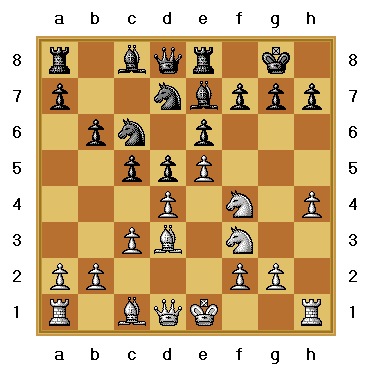
“Religion and Chess”
by Bill Wall
Chess (shatranj) was a legal issue after Mohammad died in 642 A.D. In 655 his son - in - law, Caliph Ali Ben Abu-Talib disapproved the game for his sect of Muslims because of the graven images. In 680 the 50th rule of canons was interpreted as forbidding Chess. But the caliphs themselves played and had Chess players in their circle of influence. Legal scholars debated the merits of Chess. It was legal to play Chess if not played with items of chance (dice) and there were no betting or gambling on Chess.
It was still disapproved in 725 by Sulaiman ibn Yashar but still popular among caliphs, especially when they moved their capitol to Baghdad in 750 and took their top Chess players with them.
The caliph al-Mahdi wrote a letter to Mecca religious leaders to give up gambling with dice and Chess in 780, but he died in 785 and caliph al-Rashid came to power who was an avid Chess player.
By 810 the top Chess players in the world were known and recognized and all had sponsors by powerful caliphs.
In fact, the word Grandmaster was introduced by caliph al-Mamun in 819 AD. Chess was getting serious in India as well but tolerated. By 900 there was a problem of players actually wagering fingers in their Chess matches - you lose, you cut off a finger.
The Egyptian al-Hakim banned Chess in Egypt in 1005 and ordered that all Chess sets and pieces be burned in Egypt.
Chess had picked up in Europe and pretty soon many of the clergy were spending more time playing Chess than saving souls.
In 1061 Cardinal Damiani of Ostin forbad the clergy from playing Chess. He died in 1072 and Chess was resumed in his domain. By 1093 the Eastern Orthodox church condemned Chess. The Church stamped out Chess in Russia as a relic of heathenism.
In Europe some members of the clergy thought that receiving a check in Chess was similar to committing a sin which one was able to redeem. A checkmate was similar to committing a sin that was perishable, and thus deadly.
By 1100 Chess was accepted as a regular feature of noble life in England. It was even a knightly accomplishment to play Chess in 1106 under Petro Alfonsi. Chess was played by the upper classes and excluded women from playing the game.
By 1115, the emperor of the Byzantine Empire was a Chess addict. Despite that, it was still being banned in the churches up to 1125. John Zonares, a former captain of the Byzantine imperial guard, became a monk and issued a directive banning Chess as a kind of debauchery.
St. Bernard (1090-1153) forbade his Knights Templars from playing Chess.
Chess became more popular during the crusades, but Alexander Neckam, a British author, condemned Chess as being frivolous.
By 1195, the Jews were seriously involved in playing Chess, but Rabbi Maimonides included Chess among the forbidden games for Jews.
In 1197 the Abbot of Persigny was warning folks not to play Chess.
In 1208 the Bishop of Paris, Odo Sully, banned Chess in Paris to his clergy. It was also forbidden in Worcester, England in 1240 by the religious leadership.
In 1254 St. Louis of France restricted Chess to laymen. Provincial councils were forbidding Chess in France (Beziers).
King Henry III (1207-1272) instructed the clergy to leave Chess alone on pain of durance vile. In 1291 the Archbishop of Cantebury, John Peckman, was forbidding Chess. He threatened to put anyone on a diet of bread and water if they played Chess.
Priests were forbidden to play Chess up to 1299. The Clementine Kormch wrote a series of directions of priests.
It included no Chess play.
Chess was forbidden in Germany in 1310 after the Council of Trier.
In 1322 the Jewish rabbi Kalonymnos Ben Kalonymous condemned Chess. By 1328 the Jewish laws were interpreted by some Jewish leaders that Chess could be played, but not for money.
Chess was still forbidden in Germany up to 1329 after the Synod of Wurzburg.
Charles V (1337-1380) of France prohibited Chess.
In 1380 William of Wickham (1324-1404), founder of New College, Oxford, and Winchester College, forbade Chess. He was the Bishop of Winchester and the Chancellor of England twice.
Charles VI (1368-1422) of France continued to forbid Chess. He later became insane.
In 1405 John Huss (1369-0000?), Bohemian religious reformer, sought repentance for loss of self-control at the Chess table during a game in Prague.
In 1416 the Jews of Forli, Italy relaxed a bit and forbade all games of chance except Chess.
In 1420 Werner von Orseln, the Grand Master of the Knights of the Teutonic Order, abandoned the prohibition of Chess on the grounds that Chess was a proper amusement for a Knight.
By 1476 Chess was being played in France again under Charles the Bold.
In 1495 the Inquisition saw victims of persecutions stand in as figures in a game of living Chess. The game was played by two blind players.
Each time the captured piece was taken, the person representing that piece was put to death.
By 1500 Chess was a recognized pastime for Jews on the Sabbath.
In 1549 the Protohierarch Sylvester wrote that those who play Chess shall go to hell and be accursed on earth. This was documented in his work Domostroi (Household Government), a book of principles of family life. This was the first printed book in Moscow.
In 1550 Saint Teresa of Avila, a Spanish conventical reformer, mentioned Chess in her writings to illustrate ethics and Chess. The Church authorities in Spain proclaimed her patron of Chess players.
In 1551 Czar Ivan IV (1530-1584), Ivan the Terrible, of Russia banned Chess.
The leading clerics compiled the Stoglav Collection (council of the Hundred Chapters) in 1551, which prohibited Chess in Moscow. This same document prohibited shaving as well as beards were said to imitate the visage of God and to distinguish Orthodox males from women.
In 1575 a plague hit Cremona, Italy. Afterwards, all games were
considered evil and the cause of their troubles. All games but
Chess were banned. Chess was still banned in Russia in the
17th century. In 1649 Czar Alexei (1629-1676) found some players
playing Chess and had them whipped and imprisoned. The
Puritans were against Chess and discouraged Chess play.
Religious leaders who have played Chess include Thomas Becket
(Archbishop of Cantebury), Charles Borromeo (Bishop of Milan),
Pope Gregory VI, Pope Innocent III, Pope John Paul I, Pope John
Paul II, Pope Leo X, Pope Leo XIII, Cardinal Richelieu, and
Billy Graham.
The Ayatollah Khomeini banned Chess when he returned to Iran. It was the only country in the world that banned Chess. He banned the game because he thought it hurt the memory and could cause brain damage and that it contributed to a war-mongering mentality. Prior to that, Iran, under the Shah, was the only Arab country that organized Chess and participated in Chess tournaments, including the 22nd Chess Olympiad in Israel in 1976 (in Haifa).
In 1996 Chess and other clubs were banned from some high schools in Salt Lake City, Utah. Most of the school board is Mormon which condemns homosexuality. Rather than let gay high school students form an organization, they banned all nonacademic clubs. School board members said federal law gave them only
two options: allow all extracurricular clubs or eliminate them all. Some 30 clubs, including the Chess club, were banned for 1996-97.
Some Muslims still maintain that Chess playing is a sin.
“The Bishop”
by Bill Wall
The origin of the name of the Bishop is obscure. It was introduced in the 15th century, taking the move of the courier and placed where the Alfil used to be at the set up of the Chess pieces on a Chessboard.
The appearance of the Muslim fil was formless but with two protuberances said to symbolize the elephant from which the piece derives its name.
Perhaps these suggested the Bishops mitre, hence Bishop, the name used in
English-speaking countries since the new game gained
acceptance. The fil or al-fil was also known as the sage or old man in Italy, a Count in the oldest German references, and a fool in France.
The Spanish players knew that al-fil meant the elephant, but this was not known in other European countries.
The elephant (al-fil ) was only known to most Europeans through literature, and its use in war was hardly known at all.
The perversions of the word Alfil led to alphicus (leper), alpinus (the Alpine), africus (the African), Alpheus (a man's name), and alfiere (the standard-bearer). At a later date in
southern Europe, the name became Delphinus, with its associations with the Dauphin (Dolphin) of France.
In other countries the Bishop was known as the archer, the runner (laufer), the counsel-keeper, the secretary, the soldier, the monk, the spy (senex), the thief, and the administrator.
The original name aufin, once the ordinary name for the Bishop in France and England, was replaced by the Bishop.
The original move of the Bishop (fil) was only three squares diagonally. By 1500 it could move to any open square diagonally.
Movement and capture
The Bishop can move an arbitrary number of squares in a diagonal direction, but may not jump over occupied squares. Bishops
capture in the same way as they move along the
diagonals.
|

|
|
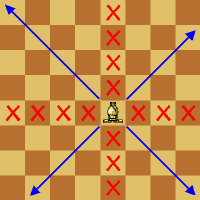
|
| |
|
|
|
The Bishop can move any number of squares in a diagonal direction and within squares of the same color. Bishops located in the center control 13 squares each. |
|
|
|
Bishops can't move in a horizontal or vertical way as shown above with red marks. Both players start with two Bishops: one for light squares and one for dark ones. |
|
|
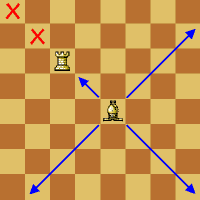 |
|
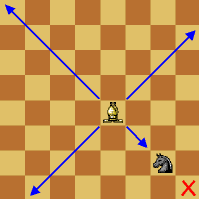 |
| |
|
|
|
Here, the Bishop is blocked by a friendly piece. The Bishop cannot move to a square occupied by the
friendly Rook nor pass the squares that lie beyond b7 or a8. |
|
|
|
The Bishop can
capture the Knight by removing it from the board and placing
itself on the square g2 but cannot move beyond the square h1 (red mark). |
|
|
Notes: for more information on the usual Chess Bishop, see Chesmayne
illustrated rules of Chess or the FIDE laws of Chess.
In the end of the middle ages, the slow Alfil was replaced in the game of Chess by the Bishop. This was part of an overall reform of the rules of Chess, making the game much faster.
In other languages, the Bishop has different names: it is also called runner (Laufer in German, Loper in Dutch), or fool (Fou in French).
Bishop graphics
|